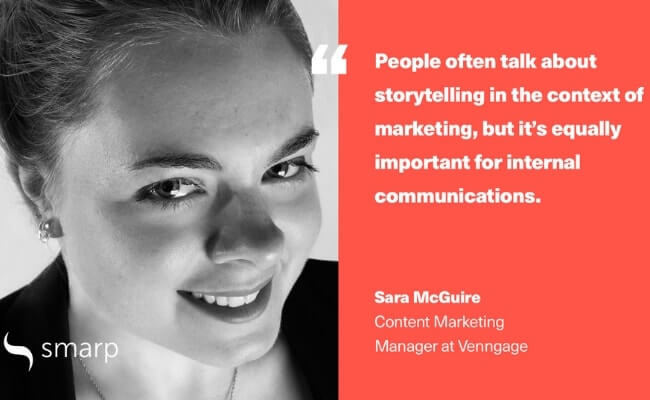In this interview, Sara McGuire, Content Marketing Manager at Venngage, explains why visual content is a great way to drive engagement on social media and how to use it to improve internal communications.
Visuals can have a tremendous impact on the success of your content strategy. Infographics, images or videos are processed by the human brain way faster than text (60,000 times faster!), they are eye-catching and easy to remember, and they also drive more engagement on social media. For example, tweets with visuals are retweeted 1.5x more times than those without any visual, posts with images generate a 98% higher comment rate on LinkedIn, and Facebook posts generate almost 40% more interactions when they include images.
Most of marketers use visual content to increase clicks, shares, and traffic to their website: HubSpot found that 80% of marketers use visual assets in their social media marketing but visuals can also be used to improve internal communications.
Just like your prospects and clients, most of your employees are visually-oriented. Sharing Infographics, creative presentations or interactive newsletters with your employees can be a great way to encourage them to keep up with the company news and to build a better connection with them.
Sara McGuire, Content Marketing Manager at Venngage, explains how visual storytelling can help you take your social media campaigns and internal communications to the next level.
Hi Sara, can you tell us why visual content is the best way to reach and engage with the brand’s audience?
There are a lot of cases where communicating visually can have a big impact on your audience’s engagement. Broadly speaking, people tend to be more drawn to visuals than plain text. All you have to do is look at the popularity of visual platforms like Instagram and Pinterest to see that people love visual content!
Visuals are snackable, shareable and can easily become viral. They can also make information easier to understand, and more memorable. TechSmith surveyed over 4,500 office workers and found that employees absorb information 7% faster when they’re given text with accompanying images, versus just text.

For example, many Venngage users have told us that they’ve found visuals to increase engagement with both their customer-facing content, but also their internal communications. That’s because visuals can help you condense and simplify boring and complex information. They can help you tell stories and inspire your audience.
There’s also a feeling of authenticity that comes with looking at an image. More and more brands are taking steps to be more transparent, by showing what goes on behind the scenes at their offices, factories and warehouses, and by showcasing the people who work for them, hence the common phrase “seeing is believing.”
What are the main challenges that marketing professionals are facing when it comes to visual content production?
For a lot of smaller teams that don’t have the bandwidth to hire a designer, there seems to be a lack of confidence in creating visuals. If you don’t have much design experience, creating your own visuals can seem too difficult and time-consuming to be worth it. These marketers may also find it challenging to create enough visual content to maintain audience engagement, or to determine which types of visual content drive the most engagement.
My advice to marketers in those situations would be to test a few different types of visuals (infographics and charts, inspirational quote graphics, slide decks, etc.) to see which ones get the most engagement from your audience. Then, use the successful formats as templates for the visuals you create moving forward (of course, this is where a design tool that offers pre-made templates can help!).
Once you have tested which types of visuals your audience seems to connect with, you can reuse and repurpose your winning visuals, and begin to scale them that way. Then, you can assess how much budget you think would be worth allocating to creating visuals.
Why is it essential that brands produce visual content to tell stories? In other words, why visuals should be a part of the brand’s storytelling strategy?
If you want your brand to be memorable, people need to be able to put a face to your name.
Think of some of the most recognizable brands – you should be able to instantly conjure up their logo, their brand colors, and their general tone. That’s because visuals can elicit strong emotional responses from your audience. Do you want your brand to be perceived as fun, youthful, and welcoming? Sleek, professional, and forward-thinking?

Like I mentioned already, your audience is also more likely to trust your brand if they can see your promises in action. From your design choices on your landing pages to your video content or the types of social media posts you publish, visuals play an important role in shaping your brand identity and reinforcing your brand voice.
Visual storytelling can also improve internal communications: fun infographics or short videos can be more effective than long emails sent by the CEO, can you tell us how businesses can make their internal communications more engaging by using visuals?
People often talk about storytelling in the context of marketing, but it’s equally important for internal communications. Generally speaking, employees feel more engaged and fulfilled when they feel like they’re playing an important role. You can use visuals to help tell your brand’s story, and to include your team as star players.
If there’s important information that you don’t want your team to miss, then visualizing it and including that visual in an email, presentation, or resource hub can help the information stand out.
There are a lot of ways you can use visuals to make your internal communications engaging. To name a few, you could:
- Incorporate pictures of your team in your presentations, reports, newsletters, and social media posts to help your employees feel recognized.
- Summarize meetings with slide decks and short handouts.
- Illustrate your target customer personas to help your team be more invested in their journeys.
- Simplify boring and complex information with infographics.
According to you, what are the top visual content trends that will shape 2020?
Video is a big one – it’s been on the rise for a few years now, and more and more marketers I talk to say they’re planning on putting more time and resources into video production in the coming year.
I think we’re also going to see a lot more brands producing their own custom visuals for social media and their landing pages. Dynamic and hand-drawn illustrations are one of this year’s biggest graphic design trends, and I predict that this trend is going to carry on into 2020.
Generally speaking, I think everyone is feeling the pressure of content saturation. That’s why we’re seeing a lot more brands in “boring” industries producing fun, engaging visual content. I think that this trend is only going to increase in the coming years.
About Sara: Sara McGuire is a Content Marketing Manager at Venngage, a Toronto-based company that helps non-designers create marketing materials such as infographics, presentations and newsletters. She loves visual storytelling and finding ways to make boring information engaging. You can find creating content for Venngage’s blog and YouTube channel. Follow her on LinkedIn!










